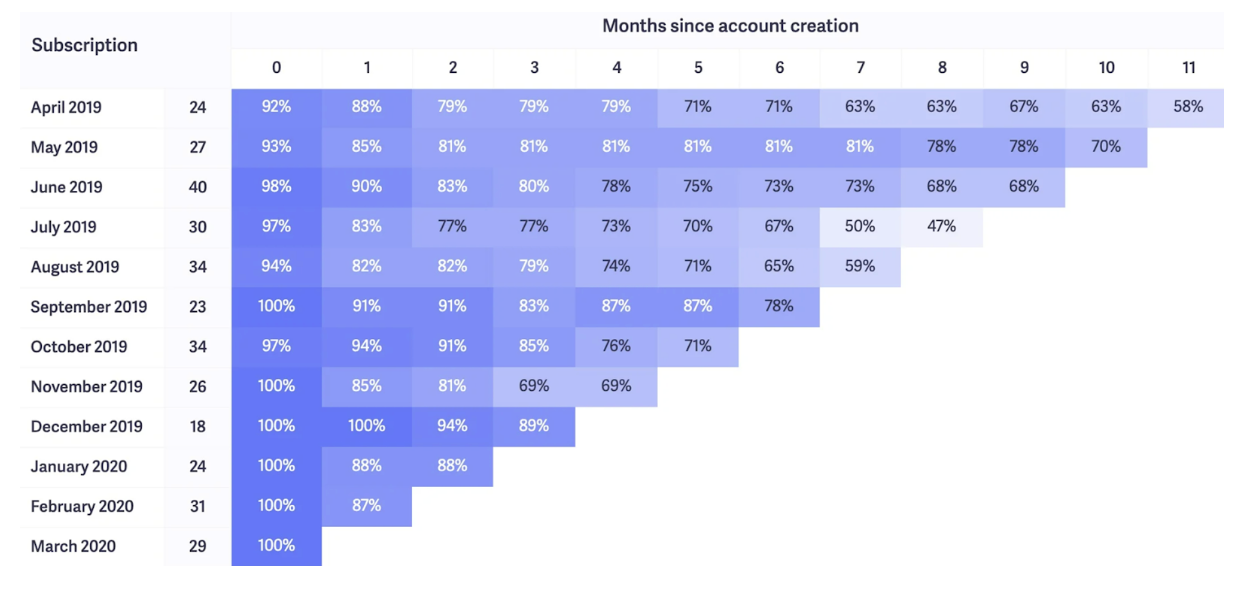Last Updated: March 25, 2025
For startup founders, understanding customer behavior is crucial for sustainable growth and success. One powerful tool in a founder’s analytical arsenal is customer cohort analysis.
This method of segmenting and analyzing groups of customers based on shared characteristics or experiences provides invaluable insights into user engagement, retention, and lifetime value.
In particular, acquisition cohorts are essential for evaluating the performance of marketing campaigns across different acquisition channels. By categorizing cohorts by acquisition types, founders can gain better insights into which channels are most effective and how campaigns can be optimized based on this analysis.
This guide will explore the details of customer cohort analysis, its importance for startups, and how to implement it effectively. We’ll cover everything from the basics of creating cohorts to advanced techniques for deriving actionable insights from your data.
Understanding Customer Cohort Analysis
Customer cohort analysis is a sophisticated analytical technique that segments a company’s user base into distinct groups, or cohorts, based on shared characteristics or experiences within a specific timeframe. This method goes beyond simple customer segmentation by incorporating behavioral analytics, which groups users based on shared traits and analyzes their behavior over time, allowing for the examination of user behavior and metrics over time.
Key aspects of cohort analysis include:
- Time-based segmentation: Users are typically grouped by when they first engaged with the product or service (e.g., sign-up date, first purchase date).
- Behavioral tracking: Each cohort’s actions are monitored over time, often in monthly or quarterly intervals.
- Metric comparison: Key performance indicators (KPIs) such as retention rates, average revenue per user (ARPU), or lifetime value (LTV) are compared across cohorts.
- Trend identification: By analyzing cohort data, businesses can identify patterns in user behavior, such as common churn points or periods of increased engagement.
- Causality insights: Cohort analysis helps isolate the impact of specific changes or events on user behavior by comparing cohorts before and after these occurrences.
This approach reveals nuanced patterns and trends often hidden in aggregate data, enabling more targeted and effective strategies for product development, marketing, and customer retention.
Definition and Purpose of Customer Cohort Analysis
Cohort analysis is a powerful tool used to analyze groups of customers and their behavior over time. It involves grouping customers based on when they signed up or converted into paying customers. By conducting a cohort analysis, you can track customer behavior, retention, churn, and revenue over time. The purpose of cohort analysis is to provide a more accurate picture of customer behavior and retention than traditional metrics like revenue growth or usage metrics. It helps you understand how various customer groups stick around (or don’t) and identify which types of customers are driving growth.
Types of Cohorts
1. Time-based Cohorts
Time-based cohorts group customers according to when they first interacted with your product or service. This is often the most common and straightforward type of cohort analysis.
Examples:
- All users who signed up in January 2023
- Customers who made their first purchase in Q2 2022
- App users who installed the app in Week 30 of 2023
Use cases:
- Measuring the impact of product changes over time
- Identifying seasonal trends in user behavior
- Comparing the long-term value of customers acquired in different periods
Analysis technique: Create a cohort retention table or chart showing how each time-based cohort behaves over subsequent time periods (e.g., months or quarters).
2. Behavior-based Cohorts
Behavioral cohorts segment customers based on specific actions they’ve taken or milestones they’ve reached within your product or service, providing valuable insights into user actions and churn rates.
Examples:
- Users who have completed the onboarding process
- Customers who have used a specific feature at least three times
- Subscribers who have upgraded to a premium plan
Use cases:
- Understanding the impact of key actions on long-term engagement
- Identifying behaviors that correlate with higher customer lifetime value
- Optimizing the user journey by focusing on critical behavioral milestones
Analysis technique: Compare retention rates, engagement levels, or revenue generation between cohorts who have or haven’t performed specific actions.
3. Size-based Cohorts
Size-based cohorts group customers based on the magnitude of their initial interaction or purchase.
Examples:
- Customers whose first purchase was under $50, $50-$200, or over $200
- Users who invited 0, 1-5, or 6+ friends in their first month
- Clients categorized by the size of their first contract
Use cases:
- Understanding how initial engagement level correlates with long-term value
- Tailoring retention strategies based on customer’s initial commitment
- Identifying high-potential customers early in their lifecycle
Analysis technique: Analyze how metrics like retention rate, upsell rate, or customer lifetime value differ across these size-based segments.
4. Acquisition-based Cohorts
Acquisition-based cohorts, also known as acquisition cohorts, segment customers based on how they were acquired or the marketing channel that brought them to your product. These cohorts are crucial for evaluating the performance of marketing campaigns across different acquisition channels.
Examples:
- Users acquired through organic search vs. paid ads
- Customers who came through a referral program vs. direct traffic
- Users who signed up during a specific marketing campaign
Use cases:
- Evaluating the long-term effectiveness of different marketing channels
- Optimizing marketing spend based on customer lifetime value by channel
- Tailoring onboarding experiences based on acquisition source
Analysis technique: Compare metrics like retention rate, conversion rate, or customer lifetime value across different acquisition channels.
5. Demographic Cohorts
Demographic cohorts group customers based on shared personal or professional characteristics.
Examples:
- Users in different age groups (e.g., 18-24, 25-34, 35-44)
- Customers in different geographic regions
- B2B clients segmented by company size or industry
Use cases:
- Identifying which customer segments have the highest lifetime value
- Tailoring product features or marketing messages to specific demographics
- Informing market expansion strategies
Analysis technique: Analyze how key performance indicators vary across different demographic segments, and use this information to inform product development and marketing strategies.
By leveraging these different types of cohorts, businesses can gain a deep understanding of their customer base, allowing for more targeted strategies in product development, marketing, and customer retention.

The Importance of Cohort Analysis for Customer Retention in Startups
For startup founders, cohort analysis offers several key benefits:
Understanding the customer lifecycle is crucial for analyzing customer behavior across different stages of their engagement with a product. This helps in identifying retention patterns and the impact of various business initiatives on customer engagement and satisfaction.
- Accurate measurement of customer retention: By tracking cohorts over time, you can precisely measure how well you’re retaining customers and identify patterns in churn.
- Insight into customer lifetime value (CLV): Cohort analysis allows you to project and compare the long-term value of different customer groups.
- Product and feature optimization: By analyzing how different cohorts interact with your product, you can identify which features drive engagement and retention.
- Marketing effectiveness: Cohort analysis can reveal which acquisition channels or campaigns lead to the most valuable customers over time.
- Forecasting and planning: Understanding cohort behavior helps in more accurate revenue forecasting and capacity planning.
Benefits of Cohort Analysis
Cohort analysis provides a deeper understanding of customers and their behavior. It helps identify why users make certain choices in your app. Cohort analysis is a valuable tool for anyone looking to improve their product. By analyzing customer behavior and retention, you can identify areas for improvement and make informed product decisions. Cohort analysis also helps you understand customer lifetime value, net revenue retention, churn rate, and company growth.
Steps of Customer Cohort Analysis
Step 1: Define Your Cohorts
The first step in cohort analysis is deciding how to group your customer cohorts. Analyzing distinct groups of customers based on shared characteristics and behaviors over time is crucial. For most startups, time-based cohorts are a good starting point. You might group customers by their signup month or the month of their first purchase.
Example:
- Cohort 1: Customers who signed up in January 2023
- Cohort 2: Customers who signed up in February 2023
- And so on…
Step 2: Choose Your Metrics
Next, decide what metrics you want to track for each cohort. For existing customers, it is crucial to measure metrics like Net Dollar Retention (NDR) to understand how much value they add to the business. Common metrics include:
- Retention rate
- Customer lifetime value (CLV)
- Average revenue per user (ARPU)
- Engagement rate (e.g., daily or monthly active users)
- Churn rate
Step 3: Collect and Organize Your Data
To perform cohort analysis, you’ll need a robust system for collecting and organizing customer data. This typically involves:
- Customer data platform: Use a platform that can track individual customer actions over time. Tools like Segment or Amplitude can be helpful for this.
- Data warehouse: Store your customer data in a centralized location. Options include Google BigQuery, Amazon Redshift, or Snowflake.
- Analytics tool: You’ll need a tool to visualize and analyze your cohort data. Many startups use tools like Mixpanel, Amplitude, or Google Analytics.
Step 4: Create Your Cohort Analysis
With your data collected and organized, you can now create your cohort analysis. This usually takes the form of a cohort table or chart.
A basic cohort table might look like this:

From left to right (first row), here’s what you’re looking at:
-
- April 2019: This is the “cohort”—customers that signed up for our product in April of 2019.
- 24: This is the number of customers in this cohort. So 24 customers signed up for our product in April 2019.
- 92%: This is the percentage of customers who remained within the first month of signing up. So in April 2019, 8% of those 24 customers cancelled.
- Each column after that shows the percentage remaining customers from that cohort after each month. So under the “1” column, we can see that 88% of the original 24 customers remain after their first month, and so on and so on.
Step 5: Analyze Your Results
Once you’ve created your cohort analysis, it’s time to interpret the results. Look for patterns and trends such as:
-
- Overall retention trends: Are newer cohorts retaining better than older ones?
- Critical drop-off points: Is there a specific time period where you tend to lose customers?
- Seasonal effects: Do cohorts acquired during certain times of the year perform better?
- Impact of product changes: Can you see improvements in retention following major product updates or new feature releases?
Differences between cohorts: Are there significant variations in performance between different cohorts? If so, what might be causing these differences?

Interpreting Cohort Analysis Results
Interpreting cohort analysis results requires a deep understanding of the data and the ability to identify trends and patterns. When reading a cohort table, it’s essential to look for trends and patterns in customer behavior and retention. You should also compare different cohorts to identify areas for improvement. By analyzing cohort data, you can identify which customer segments are driving growth, understand customer behavior and retention, and optimize customer acquisition costs.
Reading a Cohort Table
A cohort table typically shows the absolute number of customers, but it’s more interesting to look at percentages since that makes it easier to compare retention rates across different cohorts. When reading a cohort table, you should look for trends and patterns in customer behavior and retention.
Improving Customer Retention
Cohort analysis helps you understand customer lifetime value, net revenue retention, churn rate, and company growth. By applying cohort analysis insights, you can improve customer retention, optimize customer acquisition costs, and inform product development. Some actionable outcomes of doing a cohort analysis include identifying which customer segments are driving growth, understanding customer behavior and retention, and optimizing customer acquisition costs.
Advanced Cohort Analysis Techniques
As you become more comfortable with basic cohort analysis, you can start to employ more advanced techniques:
1. Multi-dimensional Cohort Analysis
Multi-dimensional cohort analysis combines multiple characteristics to create more refined cohorts. For example, you might analyze cohorts based on both signup date and acquisition channel. This approach allows for more detailed insights, revealing how different factors interact to influence customer behavior. You might discover that customers acquired through organic search in Q1 have higher lifetime value than those acquired through paid ads in the same period. This technique requires more sophisticated data analysis tools and larger sample sizes to ensure statistical significance. It’s particularly useful for businesses with diverse customer segments or complex user journeys.
2. Predictive Cohort Analysis for Customer Lifetime Value
Predictive cohort analysis uses machine learning algorithms to forecast future behavior of cohorts based on early indicators. This proactive approach helps identify at-risk customers before they churn, allowing for timely intervention. For example, an algorithm might predict that users who don’t engage with a key feature in their first week are 80% more likely to churn within three months. Implementing predictive cohort analysis requires significant data infrastructure and machine learning expertise. However, the insights gained can dramatically improve customer retention efforts and resource allocation, making it a powerful tool for scaling startups.
3. Cohort Analysis for A/B Testing
Applying cohort analysis to A/B testing allows you to evaluate the long-term impact of different variants, rather than just immediate conversion rates. This approach reveals how changes affect customer behavior over time, providing a more comprehensive view of test results. For instance, you might find that a new onboarding flow increases initial conversion but leads to lower engagement after three months. This technique requires patience, as you’ll need to wait for cohorts to mature before drawing conclusions. However, it can uncover valuable insights about the lasting effects of product changes, leading to more informed decision-making.
4. Behavioral Cohort Analysis
Behavioral cohort analysis groups users based on specific actions they’ve taken within your product, then examines how these behaviors correlate with long-term retention and value. By utilizing behavioral cohorts, you can gain valuable insights into user actions and churn rates, helping to identify which actions are most indicative of customer success. For example, you might discover that users who perform a specific sequence of actions in their first month have a 50% higher lifetime value. Behavioral cohort analysis often requires event-based analytics tools and a clear understanding of your product’s key actions. Useful for optimizing onboarding processes and identifying your product’s “aha moment” – the point where users truly understand and appreciate your product’s value.
Cohort Analysis Tools for Startups
While it’s possible to perform cohort analysis using spreadsheets, dedicated tools can make the process much more efficient and insightful. Analyzing marketing campaigns through cohort analysis is crucial to determine the effectiveness of various acquisition channels. Here are some popular options:
-
- Amplitude: Offers powerful cohort analysis features, including the ability to create custom cohorts based on user actions.
- Mixpanel: Provides robust cohort analysis capabilities, including retention analysis and funnel analysis by cohort.
- Google Analytics: While not as feature-rich as some dedicated tools, Google Analytics does offer basic cohort analysis capabilities and is free to use.
- Kissmetrics: Focuses on customer-centric analytics, including cohort analysis for both web and mobile apps.
- Heap: Automatically captures all user interactions, making it easy to create and analyze cohorts based on any combination of events.
- Tableau: Data visualization and business intelligence platform that allows users to create interactive cohort analysis dashboards. Tableau connects to various data sources, enabling users to combine customer data with other business metrics for comprehensive insights.
Qualifications and Skills for Implementing a BI System
Implementing a robust Business Intelligence (BI) system is crucial for startups looking to leverage cohort analysis and other data-driven insights to drive growth and improve decision-making. A well-designed BI system allows startups to efficiently collect, process, and analyze large volumes of customer data, enabling them to identify trends, patterns, and opportunities for improvement. To successfully implement and maintain a BI system, startups need to hire a team with a diverse set of skills and qualifications, look for the following key profiles:
- BI Architect: A BI Architect designs and oversees the implementation of the overall BI system. They should have a strong understanding of data warehousing, ETL (Extract, Transform, Load) processes, and data modeling. Key skills include:
- Proficiency in BI tools like Tableau, Power BI, or QlikView
- Experience with data warehousing technologies such as AWS Redshift, Google BigQuery, or Microsoft Azure Synapse Analytics
- Knowledge of data modeling techniques and best practices
- Familiarity with ETL tools and processes
- Strong project management and communication skills
- Data Engineer: Data Engineers are responsible for designing, building, and maintaining the data infrastructure that supports the BI system. They should have expertise in:
- Data warehousing and database management systems
- ETL frameworks and tools
- Data integration and data quality management
- Programming languages such as Python, Java, or Scala
- Big data technologies like Apache Hadoop and Apache Spark
- Data Analyst: Data Analysts work closely with business stakeholders to understand their reporting and analysis requirements. They design and build reports, dashboards, and data visualizations using BI tools. Key skills include:
- Strong proficiency in BI tools like Tableau, Power BI, or QlikView
- Excellent understanding of data modeling and data warehousing concepts
- Ability to write complex SQL queries and perform data analysis
- Knowledge of statistical analysis and data mining techniques
- Strong problem-solving and communication skills
- Data Scientist (optional): For more advanced analytics and predictive modeling, you may consider hiring a Data Scientist. They should have expertise in:
- Machine learning algorithms and predictive modeling techniques
- Programming languages like Python or R
- Data mining and statistical analysis
- Experience with big data technologies and tools
- Strong business acumen and communication skills
Remember, the specific skills and qualifications required may vary depending on the size and complexity of your BI system, as well as your industry and business requirements. It’s essential to assess your needs carefully and hire accordingly to ensure the success of your BI implementation.
Common Pitfalls in Cohort Analysis
While cohort analysis is a powerful tool, there are some common mistakes to avoid:
-
- Ignoring statistical significance: Ensure your cohorts are large enough to draw meaningful conclusions.
- Overlooking external factors: Changes in cohort behavior might be due to external events rather than changes in your product or marketing.
- Focusing only on averages: Look at the distribution within cohorts, not just average values.
- Neglecting to act on insights: The real value of cohort analysis comes from using the insights to improve your product and marketing strategies.
Over-segmentation: While detailed segmentation can be insightful, having too many small cohorts can make it difficult to spot meaningful trends.

Case Study: Cohort Analysis in Action
Let’s look at a hypothetical example of how a SaaS startup might use cohort analysis to improve their business:
StartupX is a project management tool that offers a freemium model. They decide to conduct a cohort analysis to understand their user retention and conversion rates.
They create monthly cohorts based on signup date and track two key metrics:
-
- Retention rate (percentage of users still active each month)
- Conversion rate to paid plan
After three months, their cohort analysis reveals the following:
-
- Retention rates drop significantly after the first month across all cohorts.
- Users who engage with the task assignment feature in their first week have a 50% higher retention rate.
- Cohorts acquired through content marketing have a 30% higher conversion rate to paid plans compared to those from paid ads.
- There’s a noticeable improvement in both retention and conversion for cohorts that signed up after a major UX overhaul in month 2.
Based on these insights, StartupX takes the following actions:
-
- They redesign their onboarding process to encourage early engagement with the task assignment feature.
- They increase investment in content marketing and adjust their paid ad strategy.
- They continue to iterate on their UX based on the positive impact of the recent changes.
- They implement an email campaign targeting users in their second month, when the data shows they’re most likely to churn.
Conclusion: Leveraging Cohort Analysis
Customer cohort analysis is a powerful tool that can provide startup founders with deep insights into user behavior, product performance, and business health. By segmenting users into cohorts and tracking their behavior over time, you can uncover patterns and trends that drive better decision-making across product development, marketing, and customer success.
The goal of cohort analysis isn’t just to generate pretty charts – it’s to derive actionable insights that can improve your business. Regularly reviewing your cohort data, testing hypotheses, and implementing changes based on your findings can lead to significant improvements in key metrics like retention, engagement, and customer lifetime value.
As with any analytical tool, cohort analysis is most effective when it’s part of a broader data-driven culture within your startup. Combine it with other analyses, A/B testing, and qualitative feedback to get a comprehensive understanding of your customers and your business.
Want to learn more?
Ready to take your startup to the next level? Subscribe to our newsletter for more founder-focused insights delivered straight to your inbox. We regularly share practical tips and strategies on topics like outsourcing, managing remote teams, building company culture, motivating employees, and many more.
For more in-depth content, explore our blog section. You’ll find articles on a wide range of startup challenges, from leadership and team management to growth strategies and fundraising.
Need personalized guidance? We’re here to help. Our team of experienced startup coaches offers tailored support to address your specific needs. Whether you’re struggling with team dynamics, strategic planning, or any other aspect of startup management, we can provide the expertise you need to overcome obstacles and drive your business forward. Now, we also offer a free consultation to see whether there is a fit.
Don’t hesitate to reach out – let’s build your startup success story together.
Interested in Coaching?
Schedule a Free Call

Understanding the Venture Capital Raising Process: A Step-by-Step Guide for Founders
Raising venture capital is a critical milestone for many startups, providing the necessary fuel for rapid growth and scaling. However, the fundraising process can be complex, filled with unfamiliar terms and intricate mechanics.

Top HR Software Solutions for Startups – Features, Pricing and Comparisons
For startups, managing human resources effectively is crucial for growth and success. As teams expand and operations become more complex, the right HR software can streamline processes, ensure compliance, and foster a positive work environment.

How Startup Equity Works: Key Concepts, Vesting, and Calculation Explained
Startup equity is a fundamental concept for founders and early employees, yet it’s often misunderstood. This guide breaks down the essentials of startup equity, from basic definitions to complex calculations, helping you navigate this crucial aspect of your company’s financial structure.

Join the tribe
Receive a free white paper on what “Founder Coaching” is and its benefits by signing up to our mailing list. We provide practical advice and helpful reflections to reach your full potential in work and life.
Frequently asked questions
Who can benefit from Coaching?
Our coaching is tailored to founders of startup companies who seek to grow their businesses, develop personal leadership skills, and maintain their health under pressure.
How do I join Advance Coaching?
Interested founders can set up a discovery call through our website. The application process includes a brief questionnaire about your startup and goals, followed by a consultation call to ensure our program aligns with your needs.
What results can I expect from coaching?
Coaching addresses the areas of your work / life that you want to improve. Whether that is in specific aspects of leadership skills, having more clarity and confidence in your business positioning and strategy, resolving conflicts with your Co-Founder or experiencing enhanced personal health – coaching will identify and strengthen your unique areas for growth.
What is the cost of Advance Coaching?
Pricing depends on your individual needs. Please book a Discovery call to find out more.



